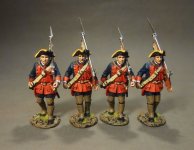THE RAID ON ST. FRANCIS 1959
The 60th (Royal American) Regiment of Foot, better known under its later name, The King's Royal Rifle Corps, has long been associated with Canada. After Braddock's defeat by the French and Indians in 1755, authority was granted to raise a regiment of four battalions to be recruited in Germany and from German colonists in North America. The regiment was named the 62nd, or Royal American, Regiment of Foot; but it was re-designated the 60th (Royal American) Regiment of Foot in February 1757. Recruiting for the Royal Americans in North America was disappointing, and more than half its strength was drafted from men rejected by British regiments in Ireland. From this unlikely collection of foreigners and cast-offs was fashioned one of the most renowned corps of the British Army.
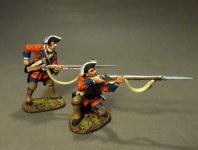
RRB60-15
THE RAID ON ST. FRANCIS 1759,
60th (ROYAL AMERICAN), REGIMENT OF FOOT,
2 Line Infantry Skirmishing ,
(2pcs)
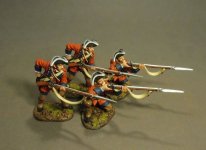
RRB60-15N
THE RAID ON ST. FRANCIS 1759,
60th (ROYAL AMERICAN), REGIMENT OF FOOT,
4 Line Infantry Skirmishing , Set #1,
(4pcs)
THE NEW JERSEY PROVINCIAL REGIMENT
The Jersey Blues were raised in 1755, by the New Jersey provincial government. It was originally composed of five companies, and was sent to the northern frontier, to guard it against the French. They were known as the "Jersey Blues", partly from the blue coats of the regiment, and partly from the similarlity of the uniform to that New Jersey used in the war of Jenkin's Ear.
On April 4 1758, the General Assembly of New Jersey voted to increase the regiment to a strength of 1,000 officers and men, including 100 grenadiers.
** PLEASE NOTE THESE FIGURES WOULD BE SUITABLE FOR THE BATTLE OF FORT CARILLON, TICONDEROGA, 8th July 1758**
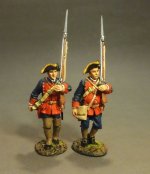
RRBNJ-05
THE RAID ON ST. FRANCIS 1759,
THE NEW JERSEY PROVINCIAL REGIMENT,
2 Line Infantry Marching,
(2pcs)
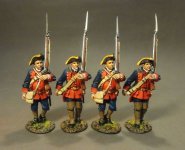
RRBNJ-05N
THE RAID ON ST. FRANCIS 1759,
THE NEW JERSEY PROVINCIAL REGIMENT,
2 Line Infantry Marching, Set#1
(4pcs)
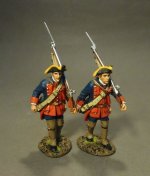
RRBNJ-06
THE RAID ON ST. FRANCIS 1759,
THE NEW JERSEY PROVINCIAL REGIMENT,
2 Line Infantry Marching,
(2pcs)
More to follow..........................
The 60th (Royal American) Regiment of Foot, better known under its later name, The King's Royal Rifle Corps, has long been associated with Canada. After Braddock's defeat by the French and Indians in 1755, authority was granted to raise a regiment of four battalions to be recruited in Germany and from German colonists in North America. The regiment was named the 62nd, or Royal American, Regiment of Foot; but it was re-designated the 60th (Royal American) Regiment of Foot in February 1757. Recruiting for the Royal Americans in North America was disappointing, and more than half its strength was drafted from men rejected by British regiments in Ireland. From this unlikely collection of foreigners and cast-offs was fashioned one of the most renowned corps of the British Army.

RRB60-15
THE RAID ON ST. FRANCIS 1759,
60th (ROYAL AMERICAN), REGIMENT OF FOOT,
2 Line Infantry Skirmishing ,
(2pcs)

RRB60-15N
THE RAID ON ST. FRANCIS 1759,
60th (ROYAL AMERICAN), REGIMENT OF FOOT,
4 Line Infantry Skirmishing , Set #1,
(4pcs)
THE NEW JERSEY PROVINCIAL REGIMENT
The Jersey Blues were raised in 1755, by the New Jersey provincial government. It was originally composed of five companies, and was sent to the northern frontier, to guard it against the French. They were known as the "Jersey Blues", partly from the blue coats of the regiment, and partly from the similarlity of the uniform to that New Jersey used in the war of Jenkin's Ear.
On April 4 1758, the General Assembly of New Jersey voted to increase the regiment to a strength of 1,000 officers and men, including 100 grenadiers.
** PLEASE NOTE THESE FIGURES WOULD BE SUITABLE FOR THE BATTLE OF FORT CARILLON, TICONDEROGA, 8th July 1758**

RRBNJ-05
THE RAID ON ST. FRANCIS 1759,
THE NEW JERSEY PROVINCIAL REGIMENT,
2 Line Infantry Marching,
(2pcs)

RRBNJ-05N
THE RAID ON ST. FRANCIS 1759,
THE NEW JERSEY PROVINCIAL REGIMENT,
2 Line Infantry Marching, Set#1
(4pcs)

RRBNJ-06
THE RAID ON ST. FRANCIS 1759,
THE NEW JERSEY PROVINCIAL REGIMENT,
2 Line Infantry Marching,
(2pcs)
More to follow..........................


